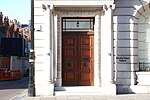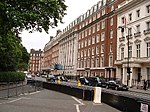Macdonald House, London
Buildings and structures completed in 1938Buildings and structures in the City of WestminsterCanada–United Kingdom relationsDiplomatic missions in LondonDiplomatic missions of Canada ... and 2 more
Diplomatic missions of the United StatesUnited Kingdom–United States relations

Macdonald House was a seven-storey Neo-Georgian style building on Grosvenor Square in Mayfair, London. It was part of the High Commission of Canada from 1961 to 2014. Macdonald House was used for the High Commission's cultural and consular functions, trade and administrative sections, immigration section, and as the High Commissioner's official residence. From 1938 to 1960, the building was the Embassy of the United States.The Government of Canada sold Macdonald House to a property developer in 2013 and vacated the building in 2014. Subsequently, Macdonald House was converted into high-end residential building named №1 Grosvenor Square.
Excerpt from the Wikipedia article Macdonald House, London (License: CC BY-SA 3.0, Authors, Images).Macdonald House, London
Grosvenor Square, City of Westminster Mayfair
Geographical coordinates (GPS) Address Nearby Places Show on map
Geographical coordinates (GPS)
| Latitude | Longitude |
|---|---|
| N 51.5115 ° | E -0.1498 ° |
Address
Grosvenor Square 3
W1K 4BN City of Westminster, Mayfair
England, United Kingdom
Open on Google Maps








